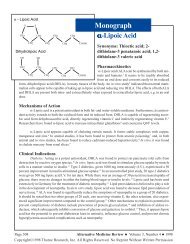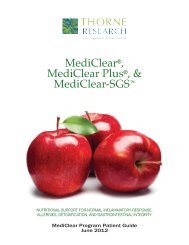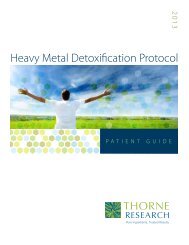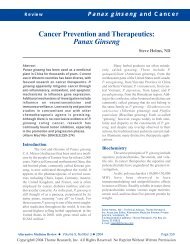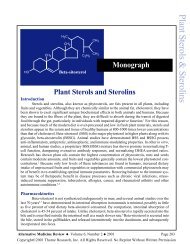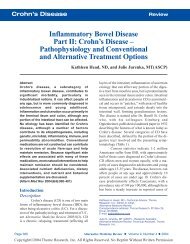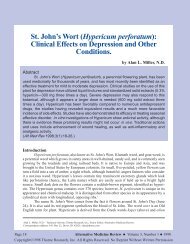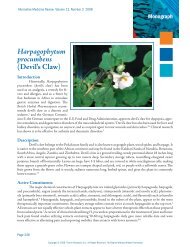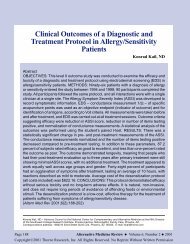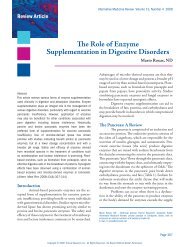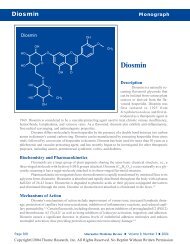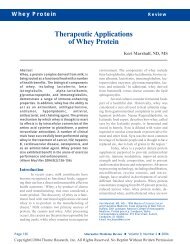Dimercaptosuccinic Acid (DMSA) - Thorne Research
Dimercaptosuccinic Acid (DMSA) - Thorne Research
Dimercaptosuccinic Acid (DMSA) - Thorne Research
You also want an ePaper? Increase the reach of your titles
YUMPU automatically turns print PDFs into web optimized ePapers that Google loves.
Figure 1.<br />
HO<br />
C<br />
O<br />
SH<br />
C<br />
H<br />
SH<br />
H<br />
OH<br />
meso - 2,3 - <strong>Dimercaptosuccinic</strong> <strong>Acid</strong> (<strong>DMSA</strong>)<br />
H<br />
SH<br />
C<br />
H<br />
SH<br />
C<br />
H<br />
C<br />
H<br />
H<br />
metals, and subsequently decreasing the<br />
body’s burden of these substances, should be<br />
an integral part of the overall treatment regimen<br />
for individuals with the above-mentioned<br />
symptomatology or a known exposure to these<br />
substances.<br />
It has long been acknowledged that<br />
sulfhydryl-containing compounds have the<br />
ability to chelate metals. The sulfur-containing<br />
amino acids methionine and cysteine,<br />
cysteine’s acetylated analogue N-<br />
acetylcysteine, the methionine metabolite S-<br />
adenosylmethionine, alpha-lipoic acid, and the<br />
tri-peptide glutathione (GSH) all contribute to<br />
the chelation and excretion of metals from the<br />
human body.<br />
Meso-2,3-dimercaptosuccinic acid<br />
(<strong>DMSA</strong>), is a water-soluble, sulfhydrylcontaining<br />
compound which is an effective<br />
oral chelator of heavy metals. Initial studies<br />
C<br />
O<br />
SO 3 H<br />
2,3 Dimercapto - 1 - propanesulfonic <strong>Acid</strong> (DMPS)<br />
H<br />
SH<br />
H<br />
SH<br />
H<br />
C<br />
H<br />
C C C OH<br />
2,3 - Dimercapto - 1 - propanol (Dimercaprol, BAL)<br />
H<br />
over forty years ago identified <strong>DMSA</strong> as an<br />
effective antidote to heavy metal poisoning.<br />
<strong>DMSA</strong> was subsequently studied for twenty<br />
years in the People’s Republic of China, Japan,<br />
and Russia before scientists in Europe and the<br />
United States “discovered” the substance and<br />
its potential usefulness in the mid-1970s. 1<br />
<strong>DMSA</strong> is a dithiol (containing two<br />
sulfhydryl, or S-H, groups) and an analogue<br />
of dimercaprol (BAL, British Anti-Lewisite),<br />
a lipid-soluble compound also used for metal<br />
chelation (see Figure 1). <strong>DMSA</strong>’s water solubility<br />
and oral dosing create a distinct advantage<br />
over BAL, which has a small therapeutic<br />
index and must be administered in an oil solution<br />
via painful, deep intramuscular injection. 2<br />
<strong>DMSA</strong>, on the other hand, has a large therapeutic<br />
window and is the least toxic of the<br />
dithiol compounds. 3<br />
Lead<br />
Lead exposure is still a public health<br />
problem in the United States, being found in<br />
approximately 21 million pre-1940 homes.<br />
Dust and soil lead, derived from flaking,<br />
weathering, and chalking paint, also contribute<br />
to chronic exposure.<br />
Lead competes in the body with calcium,<br />
causing numerous malfunctions in calcium-facilitated<br />
cellular metabolism and calcium<br />
uptake and usage, including inhibition<br />
of neurotransmitter release and blockade of<br />
calcium channels and calcium-sodium ATP<br />
pumps.<br />
The central nervous system (CNS)<br />
appears to be affected the greatest by lead.<br />
Children in particular are susceptible to its<br />
devastating effects on mental development and<br />
intelligence. Neurobehavioral deficits<br />
resembling attention deficit disorder have also<br />
been found in lead-exposed children. 4 Blood<br />
lead concentrations of 20-25 µg/100 ml can<br />
cause irreversible CNS damage in children. 5<br />
Page 200 Alternative Medicine Review ◆ Volume 3, Number 3 ◆ 1998<br />
Copyright©1998 <strong>Thorne</strong> <strong>Research</strong>, Inc. All Rights Reserved. No Reprint Without Written Permission



